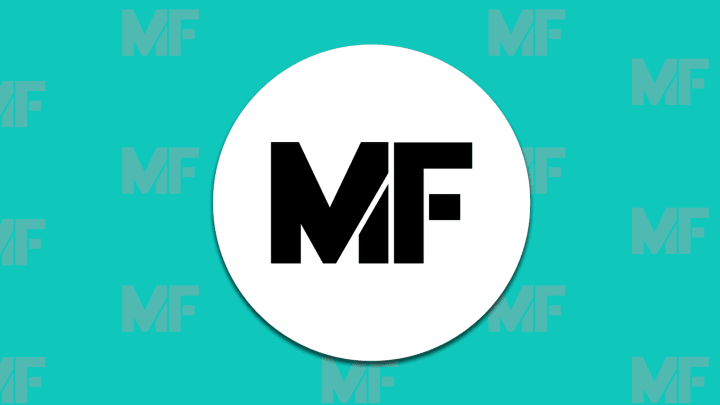12 Old Words for the Huge, Mammoth, and Gargantuan
By Mark Peters

When something—say, a canyon or mistake—is truly enormous, the same old small time words like colossal and massive don’t always get the job done. Fortunately, there are plenty of older, rarer words for the gargantuan and elephantine just waiting to make your vocabulary immensive. Use these words the next time you see something hugy.
1. UNMEET
As far back as Old English, unmeet has been a word for the immense. This played off a sense of meet meaning the Goldilocks size: just right and proper, or at least not freakishly big or small. Unless you’re a basketball player, 7-foot-tall is an unmeet height.
2. HIDEOUS
These days, hideous is only a word for the ugly, defined by the OED with words like “Frightful, dreadful, terrible, horrible.” But hideous has also been a word associated with size since the early 1300s, which makes sense, since nothing is as frightful, dreadful, terrible, and horrible as a giant monster. Poet Edmund Spenser used the term in this sense back in 1596: “Of stature huge and hideous he was, Like to a Giant for his monstrous hight.” The size-centric meaning is even clearer in an example from Jedidiah Morse’s 1796 book The American Universal Geography: “The great precipice below, which hangs over the sea, is so hideous.” With this meaning in play, even the Grand Canyon is hideous.
3. AND 4. HUGY AND HUGEOUS
The -y suffix was surprisingly productive back in days of yore, and it still is today, when you can’t even find yore on the internet. Here and there since the 1400s, the handy -y suffix could be found modifying huge. In 1728’s The Comedy of the Provok'd Husband; Or A Journey to London by Sir John Vanbrugh & C. Cibber, the odd phrase “hugey business” appears. Since the 1500s, another redundancy has been hugeous.
5. BROBDINGNAG
In Gulliver’s Travels, this was the name of a country where King Kong would feel at home, maybe not in terms of being a gorilla, but because everything was gigantic. This literary use led to the noun becoming an adjective, as shown in OED examples mentioning “Brobdingnag beehives” and “Brobdingnag genius.” Presumably, the latter would be smart enough to avoid the former.
6. HONKING
Green’s Dictionary of Slang (GDoS) traces honking back at least to the late 1980s, where it seems to have been part of college slang, turning up in references to “a honking textbook” from 1989 and a “honkin’ amount of homework” from 1992. The OED has an older example, but it feels like more of an intensifier (and euphemism for the f-word) than a size-related word. Here’s the usage from the Salisbury Times in 1943: “Great honking hornets, you creep, why don't you..get hep to the fact there's bloodshed going on!”
7. MASTEROUS
The always terrific Dictionary of Regional English (DARE) records this term for the massive and unwieldy with examples from the early 1900s of “a mastrous large school for this district” and a “masterous price.” Godzilla, you could say, was a masterous lizard.
8. DIMENSIONLESS
This is a contronym. Dimensionless has, at times, referred to stuff so tiny that it’s impossible to measure. But it’s also referred to things so hugy that they’re also impossible to measure. An 1813 use in New Monthly Magazine makes the mega meaning clear: “Here, in these almost dimensionless regions, nature is seen on a large scale.”
9. AND 10. IMMENSIVE AND GIGANTINE
Words usually have siblings, and immensive—a near-identical twin of immense—is quite obscure but means the same: immeasurable. Similarly, gigantine is a variation of gigantic, and a great word to use when describing the pyramids or frost giants.
11. PYTHONIC
This adjective has conveyed many senses of the Python from Greek mythology—a serpent-type monster which was killed by Apollo—as well as the snake with the same name. One quality all pythons (real or mythic) have is size, and so pythonic has sometimes described ginormousness. A 1903 issue of Blackwood’s Edinborough Magazine refers to “Huge wooden sheds and pythonic iron pipes.”
12. FATTENING HOG
Fairly or unfairly, the pig is the patron farm animal of hugeness. So it’s no surprise this doubly bulky term refers to the biggish. DARE records a 1954 example from Tennessee of “Fattening hog post card” referring to “A jumbo-sized post card.” What a useful term. There could be fattening hog meals, fattening hog buildings, fattening hog paperwork, and fattening hog offensive linemen. I hope to one day read about a humanitarian with a heart as big as the fattening hog outdoors.